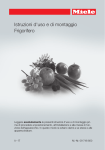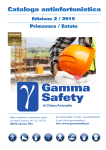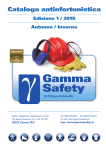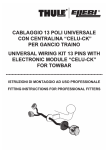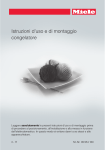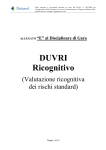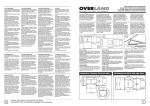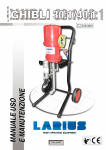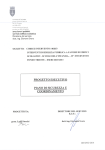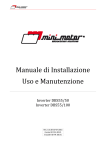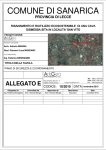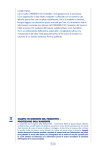Download libretto prodotto - certificato di qualità product
Transcript
LIBRETTO PRODOTTO - CERTIFICATO DI QUALITÀ PRODUCT HANDBOOK - CERTIFICATE OF QUALITY Complimenti per aver acquistato un divano di qualità “SEDUTA D’ARTE”. Un prodotto esclusivo, con design innovativo. È stato realizzato con soli materiali di qualità ed è stato costruito con la massima cura da mani esperte. In questo manuale potete trovare le caratteristiche tecniche del prodotto e tutte le informazioni necessarie per il corretto uso e l’opportuna manutenzione. 2 COME COSTRUIAMO I NOSTRI DIVANI Tutti i prodotti di marca Seduta d’Arte sono realizzati esclusivamente nei nostri stabilimenti, avendo quindi il pieno controllo di ogni fase di lavorazione: dalla concia delle pelli grezze al fusto e all’imbottitura, dal taglio e cucito, all’assemblaggio, all’imballaggio e, infine alla spedizione. Tutto ciò avviene nel pieno rispetto dell’ambiente e della sicurezza sui luoghi di lavoro, in ottemperanza alle più rigorose normative nazionali e comunitarie. Ogni nostro prodotto, è realizzato a mano, con cura e passione artigianale, per questo motivo le misure riportate nelle schede tecniche di questi mobili imbottiti sono da ritenersi indicativi e pertanto non potranno essere prese in considerazione contestazioni ad esse inerenti. In fase di produzione l’uso della tecnologia informatica consente a Seduta d’Arte di gestire la commessa in un’ottica logistica di “just in time” attraverso un sistema che è in grado, in tempo reale, di monitorare ciascuna fase del ciclo di lavorazione e di verificarne qualità e puntualità nei tempi di consegna. Prima di raggiungere le vostre abitazioni, è possibile che il nostro divano abbia dovuto compiere un lungo trasporto che può averne pregiudicato l’aspetto esteriore, una volta sballato pertanto, potrebbero notarsi alcuni avvallamenti e pieghe irregolari. Non c’è da preoccuparsi perché sono dovute al trasporto. I segni scompaiono dopo alcuni giorni di utilizzo. Per velocizzare il processo di riassestamento basta battere con le mani i cuscini modellando il rivestimento. La garanzia dei nostri divani non risulta valida nel caso in cui i prodotti siano smontati, modificati o riparati da persone diverse da personale autorizzato da Seduta d’Arte. La garanzia altresì non sarà valida anche nel caso in cui sia stato adottato un processo di manutenzione e pulizia della pelle (o di qualunque altro rivestimento), non espressamente indicato in questo libretto o comunque non idoneo, che sia fatto dal proprietario del divano o da chiunque da lui autorizzato. Su questo libretto sono riportate le principali precauzioni d’uso e di manutenzione da adottare, i danni che possono essere derivati dalla mancata osservazione di dette regole non sono da considerarsi difetti di fabbricazione imputabili a Seduta d’Arte. 3 TELAIO I telai da noi utilizzati sono ottenuti impiegando legname di qualità che garantisce la solidità e quindi la resistenza dei nostri divani alle sollecitazioni. I materiali scelti vengono testati con l’intento di controllarne la resa in ogni condizione atmosferica e nel corso del tempo. La struttura del telaio è completata da sospensioni (cinghie) ad alta resistenza che, conservando nel tempo la loro caratteristica elasticità, conferiscono con l’imbottitura un ottimo comfort. Avvertenze Per conservare intatto nel tempo il telaio del vostro divano, basterà seguire le seguenti accortezze: • evitare di sedersi sulla spalliera e sui braccioli; • evitare di sollecitare il divano con urti violenti; • evitare di spingere o strisciare il divano durante il suo spostamento. 4 IMBOTTITURE Relativamente alla struttura e alla linea estetica di ogni modello, utilizziamo tre diversi tipi di imbottiture: • Poliuretano espanso • Fibra di poliestere • Piume d’oca Rivestimento Tramezza Ovattato Poliuretano Masonite Fibra di Poliestere o Poliuretano Cinghie elastiche per divano Struttura in legno Il poliuretano espanso giunge in blocchi di diversa densità. La densità di ogni blocco è garantita da un certificato di analisi chimica e viene testata periodicamente sottoponendo il poliuretano ad un certo numero di battute per verificarne la resistenza all’uso. Le fibre di poliestere si presentano come fiocchi di filamenti di poliestere piuttosto sottili, tali da assicurare una considerevole morbidezza. I fiocchi, soffici e vaporosi, vengono utilizzati per imbottiture di spalliere e braccioli del divano dove poggiano le parti più delicate del corpo. La piuma d’oca, sterilizzata e controllata, è un materiale pregiato per la sua notevole morbidezza. Viene utilizzata nelle imbottiture di spalliere per esaltare il comfort del prodotto. È un prodotto antistatico e sanitariamente sicuro grazie agli innovativi processi di lavaggio e sterilizzazione. Le piume d’oca possono essere all’occorrenza abbinate alla fibra di poliestere di cui sopra, o ad un inserto di poliuretano espanso per trovare il miglior connubio di comfort di tutti questi materiali. 5 Uso e manutenzione INFORMAZIONI SUL NUOVO DIVANO I nostri divani non esigono una specifica manutenzione se non quella legata alla ordinaria cura. Se dopo aver tolto l’imballo si notano alcuni avallamenti e pieghe irregolari, non c’è da preoccuparsi perché sono dovute al trasporto. I segni scompaiono dopo alcuni giorni di utilizzo. Per velocizzare il processo di riassestamento basta battere con le mani i cuscini modellando il rivestimento. PRIMA DELLA MODELLATURA DOPO LA MODELLATURA È nomale che il rivestimento dei cuscini in piuma presenti sempre delle pieghe ed appaia non uniforme. I cuscini vanno periodicamente battuti con la mano al fine di ricomporre uniformemente l’imbottitura ed eliminare le pieghe. 6 Avvertenze •Nei primi mesi di vita, le imbottiture in poliuretano espanso spesso si ammorbidiscono per poi stabilizzarsi in modo definitivo; le prime volte che una persona si siede sollecita la seduta in modo da provocare la rottura delle micro-celle di cui il poliuretano è composto. Tale rottura, del tutto naturale per questo tipo di materiale, comporta un leggero ammorbidimento. •É del tutto normale, inoltre, che la morbidezza di una seduta/spalliera imbottita con poliuretano espanso si rilevi diversa da quella di altri elementi del divano, in funzione dello specifico uso a cui sono destinati. Questo aspetto, in ogni caso, tenderà a scomparire dopo i primi mesi di corretto utilizzo. • Dopo l’assestamento naturale dell’imbottitura, potreb- bero crearsi delle leggere pieghe sul rivestimento: sono pieghe normali e dipendono dall’assestamento che anche la pelle subisce durante i primi mesi di regolare utilizzo. PRIMA DELL’USO DOPO L’USO I PIEDINI I piedini, in quanto parte integrante del divano, vengono attentamente disegnati e realizzati con materiali adatti ad assicurare un ottimo effetto estetico. In alcuni modelli i piedini sono già montati in fase di produzione; in altri modelli, invece, vengono imballati insieme al divano e montati solo dopo il trasporto. Avvertenze • Evitare di aprire l’imballo del divano con oggetti ap- puntiti e taglienti perché potrebbero danneggiare il rivestimento. 7 • Stendere il foglio di cellophane sul pavimento e ca- povolgere il divano sulla spalliera per il montaggio dei piedini evitando di afferrarlo dai cuscini. • Avvitare i piedini con forza. Per riposizionare il divano, occorre alzarlo e farlo ruotare senza far leva sui piedini per evitare di danneggiarli. • I piedini in legno possono presentare alcune differenze di tonalità e venature: si tratta di peculiarità naturali del legno. • Evitare di spostare il divano trascinandolo o alzandolo dai braccioli: il giusto trasporto deve avvenire soltanto sollevandolo dal fondo. IL RIVESTIMENTO Per i nostri divani utilizziamo i seguenti rivestimenti: • Pelle • Microfibra • Tessuto 8 Cura del rivestimento in pelle La pelle è un materiale nobile, resistente e prezioso che dura nel tempo e migliora le sue qualità estetiche con il passare degli anni. Grazie alla sua proprietà di elasticità e soprattutto di traspirazione, si adatta alla temperatura corporea, avvolgendo con calore durante l’inverno e dando una piacevole sensazione di freschezza in estate. Le pelli vengono selezionate nei luoghi d’origine e lavorate nelle migliori concerie italiane. Ogni manto presenta segni naturali in superficie che ne dimostrano l’autenticità: cicatrici, smagliature, rughe, punture d’insetto, venature di colori e grane. Sui divani in pelle, col tempo, potranno comparire grinze o doppie pieghe: sono dovute alle naturali caratteristiche della “vera pelle”. 9 10 Basso di fiore Cicatrice chiusa Differenza di grana Differenza di tonalità Puntura di insetti Rughe Smagliature Venature LE PELLI EASY LIVING (pigmentate) Questa pelle, morbida e resistente, si presenta ricoperta da un leggero strato protettivo che preserva la superficie dalle macchie mantenendone inalterata la bellezza. Sono pelli adatte ad arredare gli ambienti più frequentati della casa. PULIZIA DELLA PELLE EASY LIVING • Spolverare periodicamente con un panno bianco, asciutto e non abrasivo. • Per le macchie di bibite, caffè, tè, latte, cioccolata, olio, grassi, cosmetici, fondotinta: rimuovere rapidamente il liquido dalla superficie tamponando con un panno o carta assorbente. In un secondo momento prendere un panno pulito imbevuto di una soluzione d’acqua e sapone neutro e strofinare in modo delicato dall’esterno verso l’interno della macchia. Evitare di inzuppare la superficie della pelle e provvedere ad asciugarla subito con un panno pulito (non va bene, invece, asciugare la pelle esponendola alla luce diretta del sole o con l’asciugacapelli). Attenzione! Solo acqua e sapone neutro sono adatti a questa operazione; le sostanze detergenti aggressive possono danneggiare irrimediabilmente la pelle, causando crepe e scolorimento. 11 Avvertenze • Tenere il divano lontano (almeno 50 cm) da fonti di calore come termosifoni o stufe. •Per mantenere vivo il colore del rivestimento, evitare l’esposizione diretta alla luce del sole o di lampade potenti. IIIIIIIIII IIII I IIIIIIIIIII IIIIIIIIIIIII I II I III IIIIIIIIIIII IIII • Ogni divano rivestito in pelle è unico, per cui, quando acquistate un nuovo divano con rivestimento identico ad uno già in vostro possesso, è possibile che tra i due si notino leggere differenze di tonalità. •Non lasciare giornali e/o riviste sul divano. L’inchiostro della carta potrebbe essere assorbito dalla pelle. •Evitare l’uso di indumenti e materiali che possono perdere il colore (soprattutto i jeans) può essere assorbito dalla pelle. •Evitare l’uso di indumenti e materiali che hanno borchie o parti in metallo che possono danneggiare la pelle. •La pelle è un materiale che ha bisogno di microumidità. Di tanto in tanto nei giorni piovosi, aprire le finestre della stanza in cui si trovano i divani. •Utilizzare equamente tutti i posti di seduta dei divani e poltrone in modo che possibilmente tutti abbiano una usura equilibrata. 12 LE PELLI NATURAL LIVING (semianiline ed aniline) Queste pelli, morbide e vellutate, sono lavorate senza alterare le caratteristiche originarie dei manti. Differenze di grana, cicatrici, rughe, venature, variazione nelle tonalità del colore o qualsiasi altra traccia sono prova della assoluta genuinità e testimonianza del pregio del materiale. PULIZIA DELLA PELLE NATURAL LIVING • Spolverare periodicamente con un panno bianco pulito, asciutto e non abrasivo. • Per lo sporco secco: pulire delicatamente la superficie con un panno asciutto, l’eccessivo strofinio può causare danni al rivestimento. • Per le macchie da sostanze solubili in acqua come bibite, caffè, tè, latte, marmellata: rimuovere rapidamente il liquido dalla superficie tamponando con un panno bianco non abrasivo o carta assorbente. In un secondo momento, con un panno inumidito con poca acqua, strofinare in modo delicato dall’esterno verso l’interno della macchia. Evitare di inzuppare la superficie della pelle e provvedere ad asciugarla subito con un panno pulito (non va bene, invece, asciugare la pelle esponendola alla luce diretta del sole o con l’asciugacapelli). • Per le macchie da sostanze grasse come olio, ketchup, maionese, cioccolata: rimuovere in modo delicato la sostanza dalla superficie con carta assorbente, avendo cura di non premere per evitare che lo sporco penetri nei pori della pelle. Con un panno pulito, imbevuto di una soluzione di sapone neutro molto diluito, strofinare delicatamente dall’esterno verso l’interno della macchia. Usare esclusivamente acqua e sapone neutro non colorato e asciugare subito con un panno pulito. 13 Avvertenze •Tenere il divano lontano (almeno 50 cm) da fonti di calore come termosifoni o stufe. •Per mantenere vivo il colore del rivestimento, evitare l’esposizione diretta alla luce del sole o di lampade potenti. •Non lasciare giornali e/o riviste sul divano. L’inchiostro della carta potrebbe essere assorbito dalla pelle. •Evitare l’uso di indumenti e materiali che possono perdere il colore (soprattutto i jeans) può essere assorbito dalla pelle. •Evitare l’uso di indumenti e materiali che hanno borchie o parti in metallo che possono danneggiare la pelle. •La pelle è un materiale che ha bisogno di microumidità. Di tanto in tanto nei giorni piovosi, aprire le finestre della stanza in cui si trovano i divani. •Utilizzare equamente tutti i posti di seduta dei divani e poltrone in modo che possibilmente tutti abbiano una usura equilibrata. 14 LA MICROFIBRA É un rivestimento innovativo e moderno, piacevole al tatto e facile da pulire. La microfibra è trattata con una sostanza idrorepellente che forma una protezione molecolare intorno alle fibre rendendola resistente alle macchie di grasso e liquidi. Pulizia e cura della microfibra Per mantenere la sua naturale freschezza, utilizzare una semplice spazzola a setole morbide. La microfibra è facilissima da smacchiare, basta seguire alcuni semplici consigli. •Succo di frutta, marmellata, gelatina, sciroppo, ketchup: usare acqua tiepida, risciacquare tamponando con acqua pulita. •Sangue, uovo, feci, urina: usare acqua fredda, evitare l’acqua calda che fa coagulare queste sostanze, risciacquare tamponando con acqua pulita. •Liquori, alcolici, vino, birra, coca-cola e te: usare acqua tiepida, se resta la chiazza di colore trattarla con succo di limone e poi sciacquare bene. •Matita copiativa, cacao, cioccolata, dolci alla crema e al cioccolato, gelato e senape: usare acqua tiepida, risciacquare tamponando con acqua pulita. •Aceto, gel per capelli, salsa di pomodoro, caffè con zucchero: usare succo di limone e poi ripassare con acqua tiepida, risciacquare tamponando con acqua pulita. •Cosmetici, profumo, lucido da scarpe, olio e grasso in generale, macchie d’erba e pennarelli: tamponare con alcool etilico, poi risciacquare con acqua pulita. Per le macchie d’erba e di pennarello che sono difficili da togliere, soprattutto nel colore chiaro, è necessario intervenire al più presto, per evitare che diventino troppo secche. •Chewing-gum e cera: mettere del ghiaccio in un sacchetto di plastica, quando la sostanza si è indurita rimuoverla a pezzi, poi trattare con alcool etilico. 15 •Macchie resistenti: ripetere più volte i trattamenti descritti. Anche le macchie non solubili in acqua richiedono spesso di venire successivamente trattate con essa. •Macchie vecchie di origine sconosciuta: trattare dapprima con acqua tiepida, poi risciacquare tamponando con acqua pulita. Se si vede che la macchia comincia a sciogliersi con l’acqua, ripetere più volte il trattamento, lasciar asciugare e, se necessario, trattare con alcool etilico. TESSUTO Selezioniamo per voi i migliori tessuti, resistenti alla trazione e alla luce, e tali da garantire un rivestimento impeccabile nel tempo. A secondo del tipo di tessuto, i nostri rivestimenti richiedono due diverse tipologie di lavaggio: •Lavaggio a secco •Lavaggio in acqua Per le macchie d’olio si deve procedere rimuovendo il liquido delicatamente, tamponando con un panno assorbente e, infine, smacchiando a secco (con percloroetilene). Il lavaggio a secco è un’operazione che prevede la pulizia del rivestimento mediante solventi organici. Se il rivestimento è sfoderabile, il lavaggio a secco comprende la pulitura, il risciacquo e l’asciugatura e dopo il lavaggio è indispensabile stirare il rivestimento secondo le indicazioni riportate sull’etichetta. Per questo tipo di rivestimento lavabile a secco bisogna intervenire subito sulla macchia tamponando con un panno morbido (o carta assorbente), pulito e non colorato. Per le macchie d’olio si deve procedere rimuovendo il liquido delicatamente, tamponando con un panno assorbente e, infine, smacchiando a secco (con percloroetilene). Avvertenze • Per il lavaggio a secco, suggeriamo di rivolgersi ad una lavanderia specializzata. • Prima di procedere con la smacchiatura a secco sarebbe consigliabile provare la risposta del tessuto in un punto del rivestimento meno esposto alla vista. 16 Il lavaggio in acqua è un procedimento che prevede la pulizia in acqua del rivestimento in tessuto nel caso in cui questo sia possibile. Se il rivestimento è sfoderabile il lavaggio in acqua comprende la pulitura, il risciacquo e l’asciugatura e dopo il lavaggio è indispensabile stirare il rivestimento secondo le indicazioni riportate sull’etichetta. É consigliabile pulire periodicamente con una spazzola a setole morbide questo tipo di rivestimento lavabile in acqua. Nel caso in cui si dovessero formare delle macchie di sporco bisogna ricordarsi sempre di pulire con un delicato movimento rotatorio che agisce dall’esterno della macchia verso il suo interno. Quando l’unico modo per rimuovere il segno di sporco è usare sostanze solventi, è importante non versarle direttamente sulla macchia, ma bagnare un panno pulito e procedere senza sfregare eccessivamente la parte. Avvertenze • Per il lavaggio in acqua del rivestimento, è necessario prestare attenzione alla temperatura massima del lavaggio, riportata sull’etichetta del divano acquistato. • Provare sempre il prodotto detergente in un punto nascosto del rivestimento, per assicurarsi che non sia dannoso per il tessuto. 17 Pulizia del tessuto •Liquori: tamponare con panno bianco non abrasivo o carta assorbente e rimuovere la macchia. Se la macchia persiste, lavare esclusivamente con schiuma di sapone neutro non colorato. In seguito smacchiare solo con alcool denaturato diluito in acqua al 15%. Asciugare subito con dell’aria calda usando un asciugacapelli facendo in modo di dirigere il getto d’aria dall’esterno verso l’interno della zona umida. •Bibite/vino: tamponare con panno bianco non abrasivo o carta assorbente e rimuovere la macchia. Se la macchia persiste, smacchiare esclusivamente con aceto diluito in acqua al 50%. Lavare solo con schiuma di sapone neutro non colorato, infine tamponare la schiuma residua con un panno umido d’acqua. Asciugare subito con dell’aria calda usando un asciugacapelli facendo in modo che il getto d’aria sia diretto dall’esterno verso l’interno della zona umida. •Burro, marmellata, nutella, senape, ketchup, cioccolato, succo di frutta, caffè, tè: tamponare con panno bianco non abrasivo o carta assorbente e rimuovere la macchia. Successivamente, se la macchia persiste, lavare esclusivamente con schiuma di sapone neutro non colorato. Infine tamponare la schiuma residua con un panno usando un asciugacapelli, facendo in modo che il getto d’aria sia diretto dall’esterno verso l’interno della zona umida. 18 TABELLA CODICI E DESCRIZIONI MATERIALI Codice Descrizione CO COTONE CA CS JU LI LY ME PA PC PL PP SE VI WA WB WG WK WL WM WO WP WS YK WV CANAPA CAPRA FINE JUTA LINO LYCRA METALLO POLIAMID. ACRILICA POLIESTERE POLIPROPILENICA SETA VISCOSA ANGORA CASTORO VIGOGNA CAMMELLO LAMA MOHAIR LANA ALPACA CASHMERE YAK LANA VERGINE 19 Tabella simboli internazionali manutenzione e lavaggio 20 SFODERABILITÀ Caratteristiche del prodotto I divani e le poltrone Seduta d’Arte sfoderabili, sono realizzati in modo da consentirvi di rimuovere facilmente il rivestimento per poterlo lavare. La nostra attenzione verso il cliente e l’eccellenza del servizio è confermata, anche per questa linea, da tanti piccoli particolari: • I tessuti sono stati scelti con cura affinché mantengano inalterate le loro caratteristiche tecniche ed estetiche dopo ripetuti lavaggi. • I cuscini e la struttura del divano possono essere rivestiti con fodere che facilitano l’inserimento del rivestimento esterno e ne consentono il comodo fissaggio con velcro e cerniere. istruzioni per svestire il divano Fase 1 Se il vostro modello è dotato di barra in metallo di altri addobbi o accessori, rimuoverli o sganciarli. Fase 2 Rimuovere tutti i cuscini, aprire le cerniere e sfoderarli. 21 Fase 3 Aprire la cerniera situata dietro la spalliera, se presente. Nel caso in cui il divano sia dotato di piedini posizionati a filo esterno, vanno smontati per sfilare il rivestimento. Fase 4 Staccare il velcro, risvoltare il rivestimento lungo il perimetro esterno del divano partendo dagli angoli e proteggerlo con il nastro coprivelcro. Risvoltare il rivestimento con delicatezza per non strappare le cuciture. Ripetere le stesse operazioni per il perimetro interno del rivestimento. Fase 5 Partendo degli angoli sfilare delicatamente il rivestimento procedendo alternativamente, per alcuni centimetri, da un lato all’altro del divano. Successivamente liberare completamente il sofà dal rivestimento. 22 Avvertenze - Non rimuovere il nastro di protezione: esso dovrà essere presente durante il lavaggio. Soltanto quando il divano sarà nuovamente rivestito dovrà essere rimosso e conservato accuratamente per i successivi lavaggi. Istruzioni per vestire il divano Fase 1 Per iniziare il montaggio del rivestimento, poggiare il rivestimento sulla spalliera e i braccioli, dopo aver aperto le cerniere eventualmente presenti, sistemarlo in modo da allineare le cuciture con gli spigoli del divano. Stendere il rivestimento procedendo dalla spalliera verso la parte anteriore del divano fino a rivestirlo completamente. Chiudere la cerniera. Fase 2 Sistemare il rivestimento a filo dell’angolo fondo-spallierabracciolo,staccare il nastro e fissare il velcro. Sistemare il rivestimento sulla parte anteriore della seduta in modo da far coincidere il velcro con la giunzione tra due fodere. 23 Fase 3 Stendere il rivestimento sulle parti esterne del sofà, rimuovere il nastro e fissare il velcro lungo tutto il perimetro del sofà rivoltandolo sotto base. Fase 4 Se il piede è posizionato a filo, come in figura A, smontarlo e inserire il rivestimento nel modo corretto. Rivestire i cuscini avendo cura di sistemare le imbottiture nel giusto verso. La cucitura sulla fodera interna del cuscino deve trovarsi in corrispondenza della cerniera del rivestimento (Fig. B). Assicurarsi che il cursore della cerniera sia inserito nell’apposito alloggio (Fig. C). Nel caso in cui stiate rivestendo un divano con più di due cuscini, posizionare prima i cuscini laterali e successivamente quelli centrali. 24 LE FUNZIONI RELAX Le poltrone e i divani con meccanismo manuale. Alcuni dei nostri modelli possono essere dotati di un meccanismo reclinabile che permette di cambiare l’inclinazione della spalliera, modificare l’assetto della seduta e portare le gambe in posizione orizzontale. Le poltrone ed i divani con funzione scorrevole “ZERO WALL” (distanziati a pochi centimetri dal muro) possono essere reclinati senza scostarli dalle pareti della stanza: infatti, mediante uno speciale meccanismo, durante l’apertura la seduta e la spalliera si spostano in avanti. Per questo motivo è possibile notare lievi differenze di allineamento dietro la spalliera. Le poltrone girevoli, oltre alla funzione reclinabile dispongono anche della funzione dondolo che fa oscillare la poltrona rispetto al suo asse verticale. 25 MODALITÀ D’USO A seconda dei modelli variano le modalità di utilizzo delle funzioni reclinabili. Reclinabile con maniglia Il meccanismo viene attivato mediante l’uso della maniglia posta sulla parte esterna del bracciolo o di un tirante posto tra il cuscino di seduta ed il bracciolo. Tirando la maniglia o il tirante si apre immediatamente il poggiapiedi. Praticando col busto una pressione sulla spalliera, si fa reclinare la poltrona del tutto. Per chiuderla è sufficiente spingere il busto in avanti e accompagnare con le gambe il poggiapiedi verso la posizione iniziale. APRIRE CHIUDERE TIRANTE INTERNO 26 POLTRONA CON FUNZIONE GIREVOLE Questa funzione, dove presente, non richiede alcun dispositivo per essere attivata. Per far ruotare la poltrona basta poggiare i piedi sul pavimento e muoverli verso destra o verso sinistra. É una funzione presente solo sulle poltrone. POLTRONA CON FUNZIONE DONDOLO Questa funzione si attiva spostando verso sinistra la leva posta dietro la poltrona, oppure si avvia automaticamente nel momento in cui si aziona la leva per l’apertura del meccanismo reclinabile. Per arrestare il dondolio basta spostare la leva posta dietro la poltrona verso destra e, nello stesso tempo, muovere delicatamente la spalliera per consentire alle baionette di bloccaggio di trovare la corretta posizione d’inserimento. Avvertenze • Per pulire le parti metalliche del meccanismo usare solo un panno umido. • Evitare che i bambini giochino con il meccanismo. • Attivare il meccanismo solo se seduti in posizione corretta. • Se il meccanismo durante il funzionamento dovesse cigolare, bisogna semplicemente lubrificare le molle, le cerniere e tutte le giunzioni con normali lubrificanti spray disponibili in commercio. • Sulle poltrone con dondolo evitare di sedersi sul bordo anteriore, altrimenti la poltrona potrebbe toccare terra, danneggiandosi. • Non sedersi sulla pediera. Eccessive pressioni sulla pediera a meccanismo aperto possono piegare i leveraggi danneggiando il meccanismo. • Non sedersi sui braccioli. I braccioli sono collegati ai meccanismi. Una eccessiva pressione sui braccioli potrebbe portare ad una deformazione del meccanismo. • Non appoggiarsi sulla spalliera a meccanica aperta dalla parte posteriore del divano. Anche in questo caso si potrebbero produrre danni permanenti ai leveraggi. • Utilizzando il meccanismo relax la funzione dondolo deve essere bloccata altrimenti diventa molto difficoltoso chiudere la meccanica. 27 LE POLTRONE E I DIVANI CON MECCANISMO ELETTRICO Particolare del telecomando Particolare del pulsante Particolare del pulsante interno Alcuni dei nostri modelli sono dotati anche di un meccanismo elettrico che permette di modificare l’inclinazione della spalliera, di alzare il poggiapiedi e di cambiare l’assetto della seduta. Le poltrone e i divani sono dotati di funzione scorrevole “ZERO WALL” (distanziati a pochi centimetri dal muro) che consente di reclinare la spalliera senza spostarli dalle pareti della stanza: infatti, grazie ad uno speciale meccanismo, durante l’apertura, la seduta e la spalliera si spostano avanti. 28 Avvertenze • Per pulire le parti metalliche del meccanismo non utilizzare solventi ma solo un panno umido. • Evitare che i bambini giochino con il meccanismo. • Attivare il meccanismo solo se seduti in posizione corretta. • Evitare di toccare le parti metalliche. • Non usare il motore elettrico in fase di apertura e chiusura per più di un minuto in modo continuato. Quest’attività può bloccare il motore a causa di surriscaldamento. Per sbloccare il motore lasciare raffreddare il sistema per 5 minuti. • Sbalzi di tensione possono bloccare il motore elettrico, in tal caso si deve togliere la spina, attendere qualche minuto e reinserirla nella presa. • Prima di effettuare la pulizia o altri interventi assicurarsi di aver tolto la spina elettrica. • Non sedersi sulle pediere. Eccessive pressioni sulla pediera a meccanismo aperto possono piegare i leveraggi danneggiando il meccanismo. • Non sedersi sui braccioli. I braccioli sono collegati ai meccanismi. Una eccessiva pressione sui braccioli potrebbe portare ad una deformazione del meccanismo. • Non appoggiarsi sulla spalliera a meccanica aperta dalla parte posteriore del divano. Anche in questo caso si potrebbero produrre danni permanenti ai leveraggi. I MODELLI CON LETTO Tra i diversi modelli di divano alcuni possono diventare comodi letti. Esistono più tipi di reti: a “due pieghe” elettrosaldata, a “due pieghe trasformabile” elettrosaldata, e a “tre pieghe” ortopedica o elettrosaldata e rete pronto letto. 29 Modalità d’uso Rete a “due pieghe” elettrosaldata Prima di usare il divano con letto, togliere la linguetta in plastica che blocca la rete. Per aprire la rete a due pieghe elettrosaldata eseguire poi le seguenti operazioni: 1.Rimuovere i cuscini (ove necessario); 2.Alzare la rete prendendo la maniglia centrale e tirare verso l’esterno, facendo poggiare la barra di sostegno della rete sul pavimento; 3.Afferrare dal centro la seconda barra di sostegno, sollevarla e accompagnarla fino al pavimento; 4.Per chiudere il letto, è sufficiente invertire l’ordine delle operazioni. Per la rete a due pieghe elettrosaldata viene utilizzato un materasso a molle rivestito in policotone. 30 Modalità d’uso Rete a “due pieghe” trasformabile Se il divano è dotato di un letto, si prega di seguire i nostri consigli per una corretta apertura e chiusura della rete. Si consiglia l’uso del meccanismo solo a persone adulte. Per aprire la rete a due pieghe trasformabile eseguire poi le seguenti operazioni: La cuscinatura non va tolta, il movimento si esegue in modo semiautomatico con una semplice operazione. 1.Basta una piccola pressione sulla spalliera verso il basso, la rete si solleva e si posiziona nel modo giusto portando con se i cuscini di seduta che scompaiono sotto il materasso. Avvertenze • Per chiudere il letto, ripetere al contrario l’operazione descritta. a) b) c) d) 31 Rete a “tre pieghe” ortopedica o elettrosaldata. Per aprire la rete a tre pieghe effettuare le seguenti operazioni: 1.Rimuovere i cuscini (ove necessario); 2.Alzare la rete prendendo la maniglia centrale e tirare verso l’esterno; 3. Prendere la prima barra di sostegno dal centro, sollevarla e portarla fino al pavimento; 4. Ripetere l’operazione per la seconda barra di sostegno; 5. Per chiudere il letto, è sufficiente invertire l’ordine delle operazioni. Per la rete a tre pieghe viene utilizzato un materasso in poliuretano espanso rivestito in cotone. Avvertenze • Per la pulizia delle parti metalliche usare solo un panno asciutto. • Evitare che i bambini giochino con il meccanismo. • Prima di richiudere la rete disfare il letto. • Evitare di sedersi sull’estremità della rete. • Non sedersi o salire in piedi sull’estremità della rete. 32 I MODELLI FUNZIONALI E COMPONIBILI. Alcuni nostri modelli sono anche componibili e cioè permettono di comporre a piacere il divano a seconda di ogni personale esigenza di spazio. Il collegamento tra gli elementi è realizzato mediante agganci metallici a congiunzione. Istruzioni per il collegamento degli agganci a congiunzione Il sistema di collegamento si avvale di un aggancio metallico, montato su un elemento, che deve inserirsi nell’aggancio metallico dell’altro elemento. Telina Rivestimento 33 Montaggio Allineare i pezzi, assicurandosi che gli agganci si infilino negli elementi di aggancio dell’elemento sinistro ed accostarli fino a bloccarli. Nell’ordine: • Modulo 2 ad incastro su modulo1 • Modulo 3 ad incastro su modulo 2 • Modulo 4 ad incastro su modulo 3 Smontaggio Sollevare ed allontanare l’elemento per permettere al gancio di sfilarsi dall’alloggiamento. Avvertenze • Non sollevare e spostare il divano quando è ancora agganciato. • Ogni singolo pezzo componente una versione com- pleta, salvo diversamente specificato, è rivestito nei laterali con telina e non con il rivestimento che ricopre il divano. • Quando si uniscono delle versioni fisse e reclinabili si potrà notare nella parte posteriore/inferiore del divano componibile un disallineamento sino a circa tre centimetri. 34 DIVANI CON MECCANISMO POGGIATESTA. Alcuni nostri modelli montano il meccanismo poggiatesta, che sollevandolo permette di appoggiare la testa dando maggiore comfort. Avvertenze: Non sollevare solo da uno dei due lati. Sollevare impugnado con entrambe le mani i due estremi, destro e sinistro del poggiatesta. Sollevare dal centro del poggiatesta. Non appoggiarsi e non sedersi sul poggiatesta. Può accadere che il meccanismo del poggiatesta sembra che non funzioni correttamente, in quanto provando ad alzarlo, “non mantiene” le posizioni intermedie. Non preoccupatevi, il meccanismo non è bloccato. Molto più semplicemente è successo che non è stato raggiunto correttamente il “finecorsa” del movimento. Infatti ciò accade quando abbassandolo, non è stata raggiunta esattamente la posizione “zero”. In questo caso basterà fare una leggera pressione su tutta la superficie del poggiatesta, quando questo è in posizione bassa, come mostrato in figura, e il poggiatesta tornerà a fermarsi anche nelle posizioni intermedie. 35 36 37 Our compliments for purchasing a quality “SEDUTA D’ARTE” sofa. An exclusive product, with innovative design. Created with quality materials, our product has been made with the maximum care by experienced hands. In this manual you can find the technical features of the product and all the necessary information for proper use and correct maintenance. 38 HOW WE PRODUCE OUR SOFAS All branded Seduta d’Arte products are made exclusively in our plants, thus having full control of every stage of manufacture: from the tanning of raw hides to the frame and fillings; from the cutting and sewing, assembling, to the packaging and the final stage of shipping. All this takes place in the respect of environment and the safety of workplace, in compliance with the most rigorous national and community regulations. Each product is hand made, with handcrafted care and passion, for this reason all measurements specified in the technical specification sheets of these upholstered furniture are to be considered indicative and therefore claim issues relating to these cannot be taken into account. During production stages the use of computer technology enables “Seduta d’Arte” to manage the logistics perspective of “just in time” through a system that is able, in real time to monitor each phase of the processing cycle and verify the quality and timeliness of delivery. Before reaching your home, it is possible that our sofa has had to make a long journey, thus affecting the appearance; once unpacked, therefore, you may notice a few hollows and irregular creases. Do not worry as they are due to transport. The signs disappear after a few days of use. To speed up the process of sorting this out just fluff up the cushions and smooth up the covering with your hands modeling it. The warranty of our sofas will be considered “Not Valid” in the case of products being disassembled, modified or repaired carried out by anyone not authorized by our company “Seduta d’Arte”. The warranty will also not be valid even in the case of using a process of maintenance and cleaning of the leather (or any other covering) not expressly stated in this product handbook, or otherwise unsuitable, made by the owner of the sofa or any person authorized by him. In this booklet the main care and maintenance are to be taken; damages that can derive From the failure of observing these rules will not be considered as manufacturing faults attributable to Seduta d’Arte. 39 FRAMES The frames we use are made of high-quality timber which ensures the strength as well as the resistance of our sofas to impact stress. The materials chosen are tested with the intention to control their resistance in all weather conditions and over time. The frame structure is equipped with high-resistance webbing that keeps its characteristic elasticity over time, thus ensuring the utmost comfort along with the fillings. Warnings To keep the frame of your sofa intact, please follow the instructions below: • do not sit on the backrest and armrests; • do not hit the sofa violently; • do not push or drag the sofa when moving it. 40 UPHOLSTERY As for both the structure and aesthetic line of each model, we use three different types of upholstery: • Polyurethane foam • Polyester fibre • Feathers Covering Linings Wadding Polyurethane Masonite Polyester Fibres Or Polyurethane Elastic Webbing For Sofas Wooden Frame The blocks of polyurethane foam we use have different densities. The density of each block is guaranteed by a certificate of chemical use. The polyester fibre is made up of thin polyester filaments which are processed in such a way as to ensure beautiful softness. The flakes and fluffy flakes are used for filling backrests and armrests of the sofa where the most delicate parts of the body are. The goose feathers, sterilized and accurately controlled are a valuable material for its remarkable softness. They are used in the padding of back cushions to enhance the comfort of the product. They are antistatic and medically safe thanks to the innovative processes of washing and sterilization. The goose feathers can be combined with an appropriate polyester fiber described above or a polyurethane foam insert in order to find the best combination of comfort of all these materials. 41 Information On The New Sofa Our sofas do not need specific maintenance other than ordinary care. If after removing the packaging you see some hollows or irregular creases, do not worry, because they are due to transport. All signs disappear after a few days of use. To speed up the process of sorting this out just fluff up the cushions and smooth up the covering with your hands modeling it. BEFORE MOULDING AFTER MOULDING It is normal that the filling of feather cushions always show folds and appear uneven. The cushions should be regularly plumped by hand in order to evenly reconstruct the filling and eliminate folds. Warnings •During the first three months, polyurethane foam upholstery often softens and spreads out. It is normal that the first time a person sits down on the sofa, the micro-cells of the polyurethane foam are broken up and will consequently soften up slightly. •Furthermore, it is normal for the suppleness of a polyurethane foam seat/backrest to be different from other parts of the sofa due to the different use they are used for. These differences will disappear after the first months of regular use. 42 • After the natural settling of the filling, some slight folds may appear in the covering: this is normal and depends on the stretching of the covering during the first months of regular use. BEFORE USING AFTER USING FEET Since the feet are an important part of the sofa they are carefully designed and manufactured using appropriate materials to ensure a good aesthetic appearance. In some models, feet are assembled during the production phase; in other models, however, are packaged with the sofa and assembled only after delivery. Warnings • Do not open the protecting cellophane that wraps the sofa with sharp tools that may damage the coverings. 43 • Lay the cellophane on the floor and turn the sofa on its back without grabbing the cushions. • Screw feet on hand tight. To right the sofa, lift and turn it without pulling on the feet, to avoid damaging them. • Wooden feet can vary slightly in tone and grain: in keeping with natural wood characteristics. • Avoid moving or lifting the sofa from the arms: handling must be carried out only by lifting it from the bottom. COVERINGS For our sofas we use the following coverings: • Leather • Micro fibre • Fabric 44 Maintenance of Leather Covering Leather is a resistant high quality covering, a valuable and long-lasting material whose aesthetic qualities improve over the years. Thanks to its elasticity and to its transpiration characteristics, it adapts to body temperature, feeling warm in the winter and nice and cool in the summer. Leathers are selected in their places of origin and processed only in the best Italian tanneries. The surface of each hide shows natural marks revealing its authenticity: scars, scratches, wrinkles, insect bites, veins, colour differences and grain. On leather sofas, over time, will appear wrinkles or double folds: they are due to the natural characteristics of “genuine leather”. 45 46 Low Flower Closed Scar Grain Difference Tone Differences Insect Bites Wrinkles Stretch Marks Veins “EASY LIVING” LEATHERS (pigmented) This soft resistant leather is coated with a light film so as to protect the surface from stains without altering its beauty. These are suitable leathers to furnish the more busy environments of the house. CLEANING PROTECTED LEATHER • Dust the sofa periodically with a soft, dry and clean cloth. • To remove stains of drinks, coffee, tea, milk, chocolate, oil, fats, cosmetics, make-up etc quickly dab the surface with a cloth or absorbent paper. Then, dampen a clean cloth with a water solution or neutral soap and gently rub the stain from outer inwards. Do not drench the leather surface and dry it immediately with a clean cloth. (do not expose it to direct sunlight or use a hairdryer). Attention! Only water and neutral soap must be used for cleaning: other substances may significantly damage the leather by causing cracks and discolouring. 47 Warnings • Keep the sofa at least 50 cm away from heaters or radiators. • Exposure to sunlight or to powerful lamps cause fading. IIIIIIIIII IIII I IIIIIIIIIII IIIIIIIIIIIII I II I III IIIIIIIIIIII IIII • Each leather sofa is unique, therefore, if you buy a new sofa having the same covering as the one you already have, some slight differences in shade may be noticeable. • Do not leave newspapers or magazines on the suite. The ink of the paper may be transferred to the leather of the sofa. • Avoid the use of clothing and materials that can lose its color (especially jeans) can be transferred to the leather of the sofa. • Avoid the use of clothing and materials that have studs or metal parts, they can damage the leather. • Leather is a material that needs micro humidity. From time to time, on rainy days, open the windows of the room where the sofas are. • Use all sitting places of the sofas and chairs in the same way in order to have a balance in wear. 48 “NATURAL LIVING” LEATHERS (semi anilines and anilines) This soft velvety leather is processed without changing the original characteristics of the skin. Grain differences, scars, wrinkles, veins, variations in colour or any other marks testify the authenticity and quality of the leather. CLEANING NATURAL LEATHER • Dust the sofa periodically with a soft, dry and non abrasive cloth. • For dry stains: gently wipe the surface with a dry cloth. Excessive rubbing may cause damage to the cover. • For stains from water-soluble materials such as soft drinks, coffee, tea, milk, jam: quickly remove the liquid from the surface with a non-abrasive white cloth or absorbent paper. Afterwards dampen a cloth with some water and gently rub the stain from outer inwards. Do not drench the surface of the skin and immediately dry it with a clean cloth (do not expose it to direct sunlight or use a hair dryer). • For greasy stains such as oil, ketchup, mayonnaise, chocolate: gently remove the excess from the surface with some absorbent paper, do not press so to prevent dirt from entering into the pores of the leather. Gently rub the stain with a clean cloth using water and neutral soap from outer inwards, and immediately dry it with a clean cloth. 49 Warnings • Keep your sofa away from heaters or radiators. •To keep maintain the colour of the covering, avoid direct exposure to the sunlight or to powerful lamps . •Each leather sofa is unique, therefore if you buy a new sofa having the same covering as the one in your possession, some slight tone differences may be noticeable. •For a deepener cleaning we recommend you consult specialist companies but we cannot accept any claim for poor results due to processes of maintenance and cleaning not suitable to the type of leather. •Dust the sofa periodically with a soft, dry and non abrasive cloth. • For dry stains: gently wipe the surface with a dry cloth. Excessive rubbing may cause damage to the cover. • For stains from water-soluble materials such as soft drinks, coffee, tea, milk, jam: quickly remove the liquid from the surface with a non-abrasive white cloth or absorbent paper. Afterwards dampen a cloth with some water and gently rub the stain from outer inwards. Do not drench the surface of the skin and immediately dry it with a clean cloth (do not expose it to direct sunlight or use a hair dryer). • For greasy stains such as oil, ketchup, mayonnaise, chocolate: gently remove the excess from the surface with some absorbent paper, do not press so to prevent dirt from entering into the pores of the leather. • Gently rub the stain with a clean cloth using water and neutral soap from outer inwards, and immediately dry it with a clean cloth. 50 MICRO-FIBRE It is an innovative and modern covering, pleasant to the touch and easy to clean. Microfibre is processed with a water-repellent substance providing molecular protection around the fibres, making it resistant to greasy stains and liquids. Cleaning and care of micro-fibre To preserve its natural beauty, use a soft bristled brush. Microfibre is very easy to clean, just follow some simple suggestions. •Fruit juice, jam, jelly, syrup, ketchup: use lukewarm water and rinse by dabbing with some clean water. •Blood, egg, urine: use cold water. Avoid warm water as it makes these substances coagulate. Rinse by dabbing with cold water. •Liquors, alcoholic beverage, wine, beer, coke and tea: use lukewarm water, if the colour mark remains, treat it with lemon juice and then rinse it well. •Ink, cocoa, chocolate, cakes with cream or chocolate, ice cream and mustard: use lukewarm water, rinse by dabbing with clean water. •Vinegar, hair gel, tomato sauce, coffee with sugar: use lemon juice and then wipe with lukewarm water, rinse by dabbing with cold water. •Cosmetics, perfume, shoe polish, oil and grease in general, grass stains and felt tips: rub with ethyl alcohol, then rinse with clean water. For grass stains and felt tips, which are quite difficult to remove, especially on light colours, it is necessary to react as quickly as possible in order to prevent them from becoming too dry. •Chewing-gum and wax: put a plastic bag full of ice on the stain; when the material becomes hard remove the pieces, then treat with ethyl alcohol. 51 •Resistant stains: repeat the above described treatments as often as necessary. Even stains that are not water soluble often require to be treated afterwards with water. •Old stains of unknown origin: first of all treat them with lukewarm water, then rinse by dabbing them with cold water. If the stain begins to dissolve with water, repeat the treatment as often as necessary. Let it dry and, if necessary treat it with ethyl alcohol. FABRIC We choose the best fabrics for you, resistant to tearing and to light, so as to guarantee a flawless covering over time. According to the type of fabric, our coverings require two different kinds of cleaning: • Dry cleaning • Washing Greasy stains can be removed by dabbing the surface gently with absorbent paper and finally by dry cleaning using perchloroethylene. Dry cleaning must be carried out with organic detergents. Dry cleaning of removable covering includes cleaning, rinsing and drying; after rinsing, iron the covering according to the instructions written on the label. For coverings that can be dry cleaned, it is necessary to react by immediately dabbing with a soft, clean and colour free cloth. Warnings • For dry cleaning, we suggest to use specialized laundry. • Before dry cleaning, try the product on a hidden part of the fabric. 52 Washing is only possible when the fabric is marked ‘washable’. Washing of removable coverings includes cleaning, rinsing and drying and after washing it is essential to iron the covering according to the instructions on the label. It is recommended to periodically clean this kind of covering with a soft-bristled brush. In case of dirty stains, we recommend to clean by gently rubbing the surface from outer inwards. If the use of solvents is required, pour them onto a cloth rather than directly on the stain and gently rub the surface. Warnings • Always check the maximum temperature indicated on the sofa label for washing. • Try the product on a hidden part of the covering which is not visible to make sure that it does not damage the fabric. 53 Fabric Cleaning •Liquor: dab the surface with a non abrasive cloth or with absorbent paper and remove the stain. If the stain persists, only clean it with colourless neutral soap foam. Then remove the stain only with denatured alcohol diluted 15% with water. Immediately dry the wet area with a hairdryer from outwards in. •Drinks/wine: dab the surface with a non abrasive white cloth or with absorbent paper. If the stain persists, use only 50% diluted vinegar. Only clean with colourless neutral soap foam and finally wipe the remaining foam off with a damp cloth. Dry immediately with a hairdryer, blowing from outer inwards along the wet area. •Butter, jam, chocolate, mustard, ketchup, fruit juice, coffee, tea: dab the surface with a non abrasive white cloth or with absorbent paper and remove the stain. If the stain persists, only clean it with colourless neutral soap foam. Finally, dab the remaining foam off with a damp cloth, using a hairdryer from outwards in of the wet area. 54 CODE AND MATERIAL DESCRIPTIONS Code Description CO COTTON CA CS JU LI LY ME PA PC PL PP SE VI WA WB WG WK WL WM WO WP WS YK WV HEMP FINE GOAT JUTA LINEN LYCRA METAL POLYAMIDE ACRYLIC POLYESTER POLYPROPYLENE SILK VISCOSE ANGORA BEAVER VICUNA CAMEL LAMA MOHAIR WOOL ALPACA CASHMIRE YAK VIRGIN WOOL 55 International symbol table maintenance and cleaning Gentle Hand Washing Dry And Professional Cleaning 30° Washing (Delicates) Do Not Dry Clean 60° Washing Dry Clean With Trichlorethylene Do Not Wash Do Not Wash With Hypochlorite Light Ironing Max. 100° Wash With Hypochlorite Medium Ironing Max. 150° Dry Cleaning Needed Hard Ironing Max. 200° It Can Be Tumble-Dried Iron With Steam Do Not Tumble-Dry Do Not Wring Do Not Iron With Steam Hang To Dry When Wet Do Not Iron Possible Colour Changes On Printed Fabrics Iron Inside Out Fabric Remains Wavy Even After Ironing After Ironing 100% Cotton Fabrics It Is Normal For A Slightly Wavy Appearance 56 REMOVABILITY Product Features The Seduta d’Arte sofas are made with removable coverings so you can easily remove the cover in order to wash it. Our attention to customer and service excellence is confirmed, even for this collection by many small details: • The fabrics have been carefully chosen so after repeated washing they maintain their technical and aesthetic characteristics. • The cushions and carcass of the sofa can be covered with linings that make more easier the dressing of the outside covering and allows a comfortable fixing with velcro and zippers. Instructions to undress the sofa Step 1 If your model has a metal bar or other decoration accessories, remove or unhook them. Step 2 Remove all cushions, open the zippers and undress the sofa. 57 Step 3 Open the zipper situated behind the back, if there is any. In the case the sofa is supplied with legs fitted flush external, they must be taken away to remove the covering. Step 4 Remove the Velcro and turn up the lining around the external perimeter of the sofa starting from the corners and protect it with the velcro tape. Turn carefully the covering right side up in order to not rip up the stitching. Repeat the same to the inner perimeter of the covering. Step 5 Starting corners carefully and alternatively pull the cover for a few centimeters from one side to the other of the sofa. Then take away the covering from the sofa. 58 Warnings - Do not remove the protective tape: it needs to stay in place during washing. Only when the sofa is redressed then it can be carefully removed and stored as it is needed for future washes. Instructions to redress the sofa Step 1 To start the assembly of the covering, put it on the back and arms of the sofa, after opening the zippers if there are any; adjust hinges may be present, adjust it in order to align the stitching with the edge of the sofa. Spread it starting from the back of the sofa to the front in order to cover it completely. Close the zipper. Step 2 Place the cover with the bottom-back-arm angle, remove the tape and fix the velcro. Place the cover on the front of the seat in order to join it together with the joining of the lining between the two covers. 59 Step 3 Spread the covering the outside of the sofa, remove the tape and fix the velcro along the whole perimeter of the sofa turning it underneath. Step 4 If the foot is positioned as in Figure A, disassemble it and insert the cover properly. Cover the cushions, taking care of adjusting the padding in the right direction. The stitching on the lining of the cushion must be aligned with the zipper of the covering (Fig. B). Make sure the cursor is inserted in the correct place (Fig. C). In case you are covering a sofa with more than two cushions place first the side ones and then the central ones. 60 RELAX FUNCTIONS Relax armchairs and sofas are equipped with a manual system. Some of our models are provided with a reclining mechanism that you change the tilt of the backrest, change the position of the seat and bring your legs to a horizontal position. The armchairs and sofas fitted with the “ZERO WALL” sliding system (spaced a few inches from the wall) can be reclined even if they are near the wall; in fact, while opening them, a special mechanism allows the seat and the backrest to move forward. For this reason you may notice slight differences in alignment behind the back. In addition to the reclining system, swivelling armchairs are equipped with a rocking system that makes the armchair rotate around its vertical axis. 61 INSTRUCTIONS FOR USE Reclining systems change according to different models. Recliner with handle The mechanism is activated by using the handle located on the outside of the arm or a rod placed between the seat cushion and the armrest. By pulling the handle, the footrest immediately opens. Lean your body on the backrest and the armchair will completely recline. To return to the upright position, push your body forward and move the footrest to the starting position with your legs. Armchairs and sofas fitted with the “ZERO WALL” sliding system (spaced a few inches from the wall) can be reclined even if they are near the wall; in fact, while opening them, a special mechanism allows the seat and the backrest to move forward. OPEN CLOSE INNER TIE ROD 62 SWIVEL ARMCHAIR This function, where present, does not require any device to be activated. To rotate the chair just rest your feet on the floor and move to the right or to the left. This function is only available on armchairs. ROCKING ARMCHAIR This function is activated by moving the lever situated behind the armchair towards the left or it is automatically activated by moving the handle to open the reclining mechanism. Stop the rocking mechanism by gently moving the lever situated behind the armchair to the right and the backrest at the same time so that the blocking mechanism fits in properly. Warnings • Clean the metallic parts only with a damp cloth. • Do not allow children to play with the mechanism. • Start the mechanism only if you are sitting in the correct position. • Should the mechanism creak, oil the springs, hinges as well as all joints with any common lubricant spray available on the market. • Do not sit on the front edge of the rocking armchair since it may touch the floor and break. • Do not sit on the footboard. Excessive pressure can bend the levers damaging the mechanism. • Do not sit on the armrests. The arms are connected to mechanisms. Excessive pressure on the arms could lead to a deformed mechanism. • Do not lean on the back when the mechanism is open. Even in this case you could cause permanent damage to the levers. • When using relax mechanism the rocking function must be blocked otherwise it becomes very difficult to close the mechanics. 63 ELECTRICAL ARMCHAIRS AND SOFAS Remote details Push-button details Particular Internal Button Some of our models are equipped with an electric mechanism which allows you to change the inclination of the backrest, to lift the footrest and change the position of the seat. The armchairs and sofas fitted with the “ZERO WALL” sliding system (spaced a few inches from the wall) can be reclined even if they are near the wall; in fact, while opening them, a special mechanism allows the seat and the backrest to move forward. 64 Warnings • Do not use detergents but only a damp cloth to clean the metallic parts of the mechanism. • Do not allow children to play with the mechanism. • Start the mechanism only if you sitting in the correct position. • Do not touch the metallic parts. • Do not use the electric motor during opening and closing for more than one minute continuously. This activity may block the engine due to overheating. To unlock the engine, cool the system for 5 minutes. • Power surges may block the electric motor. In this case you must remove the plug, wait a few minutes then replace into the socket. • Before cleaning or other interventions make sure the plug has been removed. • Do not sit on footboards. Excessive pressure may bend the levers damaging the mechanism. • Do not sit on the armrests. The arms are connected to mechanisms. Excessive pressure on the arms could lead to a deformation of the mechanism. • Do not lean on the back when the mechanism is open. Even in this case you could produce permanent damage to the levers. SOFA BEDS Some models are equipped with comfortable beds. There are types of bedsprings: the “twofold” mesh, the “twofold” convertible mesh and the “three fold” wooden slats or mesh network ready for bed. 65 Instructions for Use “Two folds” mesh Before using the sofa bed, remove the plastic tab that locks the bedsprings. To open the “ twofold” bedsprings use the following instructions: 1. Remove the cushions from the seat (if necessary); 2. Raise the bedsprings by taking the middle handle and pull outward, resting the supporting bar on the floor; 3. Take the second supporting bar, lift it and pull down to the floor; 4. To close the bed, just reverse the order of operations. For the “twofold” mesh bedsprings we use a spring mattress covered in poly 66 Instructions for use “Two fold” convertible mesh If the sofa is bed equipped, please follow our recommendations for proper opening and closing of the bedsprings. We recommend the use of the mechanism to adults only. To open the “twofold” convertible use the following instructions: Operation is made with a simple movement, he cushions should not be removed, the movement is made in a semiautomatic way with a simple operation. 1. Just a little pressure on the back down and the bedspring is lifted and positioned correctly, bringing with it the seat cushions that disappear under the mattress. WARNINGS • To close the bed, reverse the operation described. a) b) c) d) 67 Wooden slats or Mesh “Threefold” Bedsprings To open the mesh, follow the instructions below: 1. Remove the cushions from the seat (if necessary); 2. Raise the bedsprings by taking the middle handle and pull outward; 3. Take the second supporting bar, lift it and pull it down to the floor; 4. Repeat the same operation for the second supporting bar; 5. To close the bed, just reverse the order of operations. For the “threefold” bedsprings we use a polyurethane foam mattress with cotton covering. Warnings • To clean the metal parts using only a dry cloth. • Do not let children close the bedsprings. • Avoid sitting on the front edge of the bedsprings. • Do not sit or to climb standing on the extremities of the bedspring. 68 FUNCTIONAL AND MODULAR MODELS Some of our models are also modular and allow to compose the sofa as you like according to each personal space requirements. The connection between the elements is achieved by metal hooks conjunction Instructions for connecting hooks The connection system uses a metal hook, mounted on an element that must fit in the coupling of another metallic part. Lining Covering 69 Mounting Align the pieces, making sure the hooks fit into the coupling elements of the left item and put them together to lock. In order: • Unit 2 joints on module 1 • Unit 3 joints on module 2 • Unit 4 joints on module 3 Disassembling: Lift and remove the item to allow the hook to slip off from the bay. Warnings • Do not lift or move the sofa until all joints have been disassembled. • Every single piece of the complete version unless otherwise noted is covered with lining on the side and not with the sofa covering. • When stationary and reclining models are joined, a difference in level of about 3-cm may be noticed in the back/lower part of the sofa unit. 70 SOFA MECHANISM WITH HEADREST Some of our models are equipped with headrests which lifted up allow you to rest your head giving greater comfort. Warnings: Do not raise just one of the two sides. Lift with both hands gripping the two outsides, right and left of the headrest. Lift the centre of the headrest. Do not lean and not sit on the headrest It may happen that the mechanism of the headrest seems to not work correctly, as, trying to lift it up, it “does not maintain” the positions in between. Do not worry, the mechanism is not locked. Simply, it happened that it did not properly reach the “final limit” of the movement. In fact, this happens when lowering it, it did not exactly reach the position “zero”. In this case, you just need to make a little pressure on the entire surface of the headrest, while it is in its low position, as shown in the picture, and the headrest and will return and get locked in the positions in between. 71 72 Seduta d’Arte srl Via dell’Orzo, 32 - 70022 Altamura (Bari) - Italy Tel. +39 080 3149600 - Fax +39 080 3160353 [email protected] - sedutadarte.it













































































